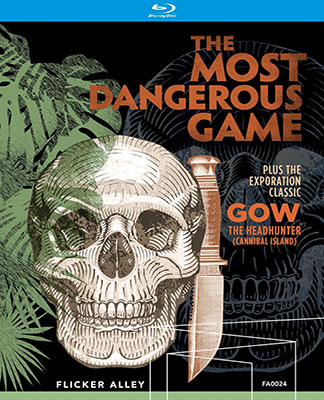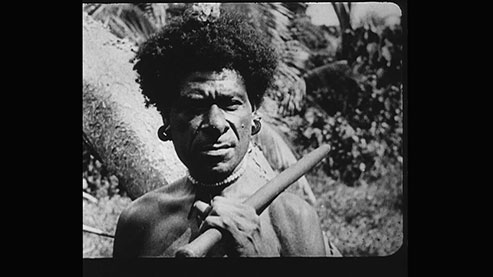
Reviews of silent film releases on home video.
Copyright © 1999-2025 by Carl Bennett
and the Silent Era Company.
All Rights Reserved. |
|
Gow
the Head Hunter
(1928)
|
Documentary producer Edward A. Salisbury headed a cinematic expedition into the south seas of the Pacific Ocean from October 1920 through February 1922. Aboard his sailing yacht utilized for the expedition, Salisbury had installed a small motion picture film processing laboratory. The footage that was shot by Thomas Middleton on that trip and that of a second expedition that started in September 1922 was later compiled into the Salisbury documentaries Black Shadows (1923) and the feature-length Gow the Head Hunter (1928), which was prepared for touring travelogue stage presentations with narration written by Salisbury and performed by William Peck.
The documentary footage of South Sea native peoples included in Gow the Head Hunter was taken on the Fiji Islands, the Andaman Islands (including footage shot by future producers Merian C. Cooper and Edward B. Schoedsack), in New Guinea, the New Hebrides, and the Solomon Islands. Some shots document individuals while others document cultural practices and daily life. The film’s appeal to silent era audiences is attributable to a combination of salacious shots of bare-breasted native women and some brief footage of body parts displayed openly in headhunter villages.
The closing section of the film leaps into a reenactment of reputed true events to tell a cinematic story that had been cooked up by Salisbury and other members of the expedition. The contrast between the staged documentary footage and the out-and-out fabricated drama is quite significant. The documentary footage is at times uncomfortable as the persons on-screen are obviously being coaxed to move in a particular way by the director off-screen, but much of it feels nonetheless to be a historical record. The dramatic reenactment, however, plays as if it were an amateur film which has little documentary credibility.
Gow the Head Hunter was reedited with a full-length recording of the narration by William Peck and rereleased as the sound film Gow the Killer (1931). Portions of two other 1929 Salisbury films, The Lost Empire (1929) and Captain Salisbury’s Ra-Mu (1929), were added to the Gow the Head Hunter footage to fill out this version. It is this silent-sound film hybrid version which was the basis of the exploitation rerelease version entitled Cannibal Island (1956).
The film, today, plays silently as straight-forward and often static documentary footage and as a sound film as a kitchy oddity. Gow the Head Hunter is not the film that other, better-known silent documentaries are — Salisbury may have been little more than a filmmaker wannabee. But, the film’s value lies in its fragments of irreplaceable historical and cultural documentation.
— Carl Bennett
|
 Flicker Alley Flicker Alley
2012 Blu-ray Disc edition
Gow the Head Hunter (1928), black & white, 61 minutes, not rated.
Flicker Alley, FA0024, UPC 6-17311-67769-4.
One single-sided, dual-layered, Region 0 Blu-ray Disc; 1.20:1 aspect ratio picture in pillarboxed 16:9 (1920 x 1080 pixels) 24 fps progressive scan image encoded in SDR AVC format at ? Mbps average video bit rate; DTS-HD Master Audio 2.0 mono sound encoded at ? Mbps audio bit rate; English language intertitles, no subtitles; 15 chapter stops; standard BD keepcase; $41.98.
Release date: 3 July 2012.
Country of origin: USA
Ratings (1-10): video: 7 / audio: 6 / additional content: 8 / overall: 7.
|

This Blu-ray Disc edition has been prepared from a 35mm print of the 1956 sound film rerelease of the film, which was retitled Cannibal Island. The footage as preserved in the source print is moderately damaged by emusion scuffing and scratches, and speckled with negative and positive dust particles. As the original footage was shot and processed under rough circumstances, it should be no surprise that some of it is in flat greytones while some of it is fairly contrasty, some reasonably sharp and some moderately soft in focus.
The high-definition video transfer is balanced and detailed, even though the source material occasionally doesn’t warrant the HD treatment. The disc encoding reveals a moderate amount of compression artifacts, which are far less prominent in HD than they would be on a standard resolution DVD. The viewing is very-good, regardless of the foregoing comments and despite the uneven print material.
Supplemental material includes a full-length audio commentary by Professor Matthew Spriggs of the Australian National University, which is somewhat enlightening and informative; and an audio interview with producer Merian C. Cooper conducted by Kevin Brownlow in 1971.
This is our recommended home video edition of the film.
|
This Region 0 Blu-ray Disc has been discontinued
and is . . .
|

|
|
|
Other DOCUMENTARY FILMS of the silent era available on home video.
|




































